The purple coneflower, more commonly known as echinacea, is a lovely perennial that is both beautiful and quite low-maintenance. With an average height and spread of around 3 feet, it brings pink-to-purple flowers that definitely add a bit of zest to your garden and a whole lot of life, attracting pollinators from all around.
With the right companions by its side, the echinacea can truly shine, making your garden a more vibrant and inviting space. Finding the proper accompaniment is always a pleasure and today we’re going to help you along with a few suggestions that we think you’ll enjoy. Let’s take a look at the top 10 echinacea companion plants and we’ll see if you agree – the right pairings can really make all of the difference in the world!
Echinacea Companion Plants
Other similar posts:
1. Bee Balm – Monarda bradburiana

A real American beauty, Bee Balm has long been a favorite of many. Available in standard and dwarf varieties that flower white, pink, purple, and red, this mint-family plant is best planted in the fall or spring and it loves to get as much sunlight as it can.
Just be sure to regularly practice dividing and digging if you don’t want it to spread – Bee Balm is full of life and it’s more than happy to start filling your yard if you let it!
- Mature Size: Standard Bee Balm reaches a mature height of 4 feet tall, with a 3 foot spread. Dwarf varieties will top out at about 15 inches with a spread of up to 2 feet.
- Flowering: Produces lovely, whorled white, pink, red, or purple flower heads in June or July.
- Key Features: Beautiful and fragrant, spaced 18-24 inches apart from your Echinacea this plant presents a perfect compliment in 4 possible colors of your choice.
2. Black-Eyed Susan – Rudbeckia fulgida
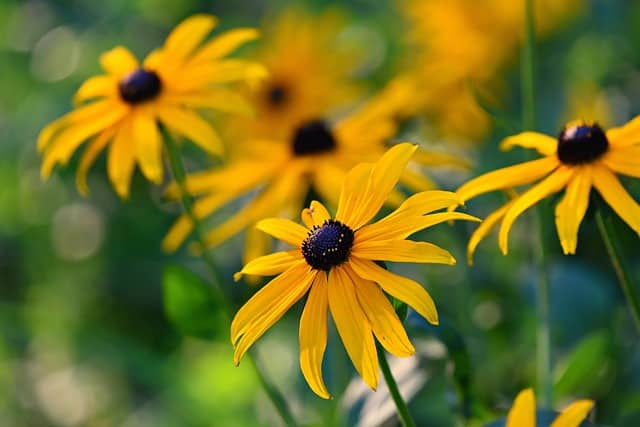
Know what goes well with purple Echinacea flowers? The daisy-like orange or yellow florets of the Black-Eyed Susan.
It’s also quite good for attracting pollinators, so you can count on butterflies and other pollinating insects to make an appearance. Once they arrive, the birds will come too, and your garden doesn’t get much more idyllic than that!
As an added bonus, if you have local deer that like to snack on your garden plants, Black-Eyed Susan is one that they prefer to leave alone.
- Mature Size: While they sometimes grow taller, Black-Eyed Susans tend to mature between 1 and 3 feet in height, with a modest spread of 12 to 18 inches.
- Flowering: You may expect the appearance of golden-yellow or vibrant orange blooms between June and September.
- Key Features: Bright, cheery flowers, with a long blooming period and a scent quite similar to sweetgrass when it’s warm outside.
3. Blue Phlox – Phlox divaricata
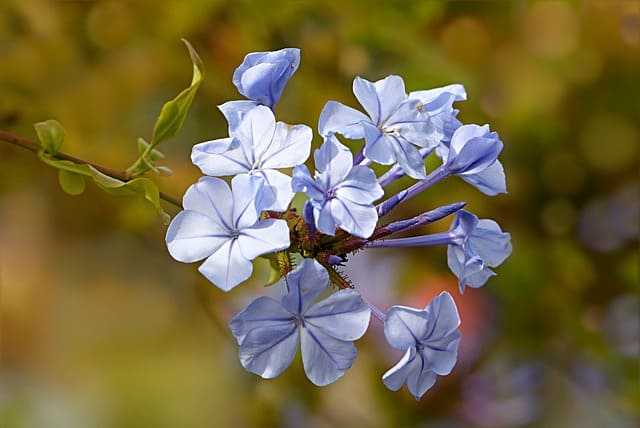
Just about the perfect companion for Echinacea’s deep-purple hues, Blue Phlox produces lavender, purple, or even rose-colored blooms that are short and sweet.
Used as a border, their diminutive size can really showcase your Echinacea and the combined blues and purples bring delicious Blueberries to mind. It’s a lovely effect and well-worth the efforts if you’re willing to put in the time!
- Mature Size: Typically 1 foot/12 inches when fully matured.
- Flowering: Rose, Lavender, and purple blooms may be expected to show themselves between late spring and early summer, lasting a month in duration.
- Key Features: With their brief blooming period, these plants make a fine border to quickly transform your garden and the tubular, 5-petaled flowers will also attract local hummingbirds!
4. Butterfly Milkweed – Asclepia tuberosa

Butterfly Milkweed brings deep orange hues into your garden, while also providing some added stability to help support your Echinacea.
This practical beauty often grows near rocky, wooded outcrops and as a result, it has a taproot that digs deeply enough into the soil to create a sturdy framework for itself and the Echinacea you’ve got next to it.
- Mature Size: Fully mature at 1 – 3 feet in height, with a spread of approximately 12-18 inches wide.
- Flowering: You can expect flat-topped, vibrant orange flowers from early spring until the late summer.
- Key Features: The scent is sweet and spicy, with a touch of honey, and the deep taproots will help to keep your Echinacea from drooping-down while providing a striking floral contrast in the form of deep orange blooms.
5. Cardinal Flower – Lobelia cardinalis

Fancy a bit of scarlet in your garden? The Red Cardinal definitely provides in this regard. Tall and thin, multiple scarlet to vermillion flowers with 5 lobes each run up and down the stem, groups with contrasting green clumps of beautiful basal leaves.
Rabbits and Deer will leave it alone, but this Cardinal Flower is a hummingbird magnet, and with its diminutive size you can place it in interesting ways to give a swathe or just a touch of striking red, as you like!
- Mature Size: Cardinal flowers reach a mature height between 3-6 feet tall, with a modest spread of 1 – 2 feet.
- Flowering: Crimson blooms should appear and stay from July to September.
- Key Features: Tall, but not too wide, Cardinal flowers don’t have much of a scent, but there are color variations of white, burgundy, or pink if you don’t fancy the standard red.
6. Catmint – Nepeta mussinii

You can double-down on the purple with a little lovely and lavender Catmint. Drought resistant and easy to grow, this plant also acts as a natural repellent for squash bugs and aphids.
Add in that the mint leaves are actually edible and quite delicious, Catmint makes an eminently practical compliment to any Echinacea arrangement.
- Mature Size: Catmint grows to be anywhere from 10-24 inches tall, with a spread that’s just 1 – 2 feet wide.
- Flowering: You can expect columns of lavender blooms between late spring to early midsummer.
- Key Features: Compact, pretty, and practical – Catmint is low maintenance but also repels insects and provides a tasty treat to spice up your salads.
7. Coral Bells -Heuchera americana
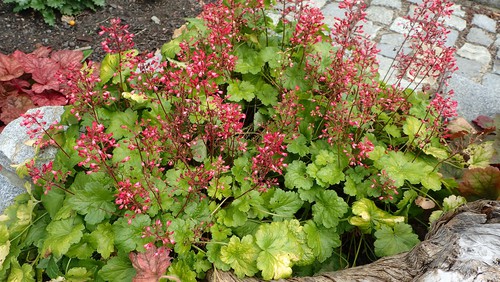
Also called ‘Rock Geraniums’, Coral Bells repel rabbits and deer alike, while also producing attractive, colorful foliage in a wide assortment of colors – including tan, cream, orange, green, and lavender, brought to you in beautiful and bell-shaped clusters.
- Mature Size: Coral Bells have a spread of 12 – 36 inches wide, with a standard height of 6-16 inches. Factor in the flower spikes, however, which may extend the plant’s reach to a total of 1 – 3 feet.
- Flowering: These lovelies tend to bloom in June and stick around for 2 months, except when there’s an early frost.
- Key Features: The wide range of colors and diminutive size can really spice up your arrangements and create some amazing custom-contrast.
8. Goat’s Beard – Aruncus dioicus
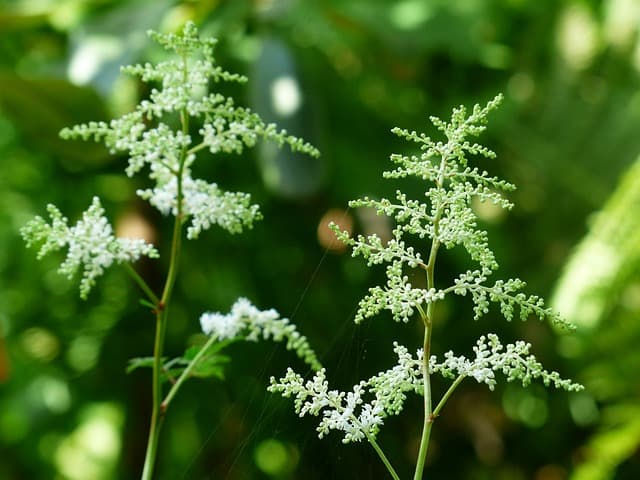
This perennial is a North American native, so it’s both beautiful and hardy. Goat’s Beard is a great way to inject a little cream color into your garden and the feathery, plumed columns seem to bloom overnight, producing tiny cream-to-white and star-shaped flowers that will peak for about 10 days.
Consider adding this with some other short-bloomers and you’re sure to have quite the enchanted, colorful springtime each and every year!
- Mature Size: Goat’s Beard grows up to 4 – 6 feet tall, with a typical spread of 2-4 feet wide.
- Flowering: The feathery flowers of this plant will make their appearance for 2 weeks in late spring or early summer.
- Key Features: While short-blooming, with multiple color choices you can set up a 2-week window of amazing color contrasts that is sure to amaze and delight.
9. Salvia – Salvia farinacea

Sometimes called Blue or ‘Mealy Cup’ Sage, Salvia is a deep blue member of the mint family and a lovely perennial to host with your Echinacea.
The deep blue or violet flowers will bring butterflies to the yard and it won’t take much effort to maintain them – these beauties are drought resistant and have close to the same care requirements as your Echinacea. They’re also fairly dense, making them a good choice for a carefully-plotted border.
- Mature Size: Salvia has a mature size of a humble 12 – 24 inches when fully grown.
- Flowering: Long bloomers, Salvia flowers make their appearance in May or June and will stick around for 6 – 8 weeks.
- Key Features: Hardy and humble, these drought-resistant blooms are perfectly sized for border-work that you may enjoy for long blooming periods each year.
10. Stonecrop – Hylotelephium spectabile
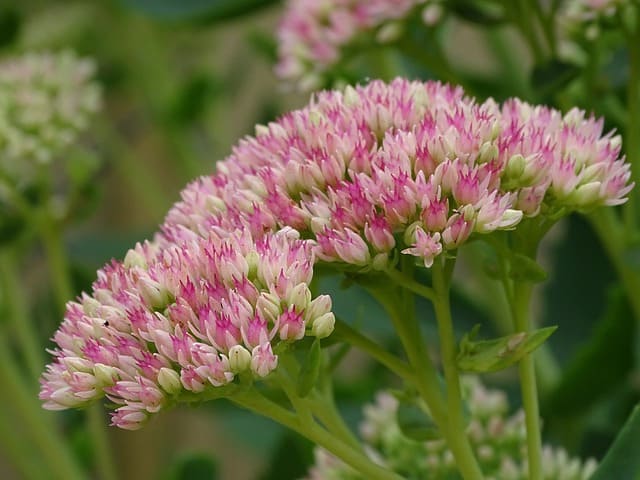
Stonecrop, also known as Sedum, comes in many varieties but the Hylotelephium spectabile is our focus for this article. A native of China and Korea, this type of Stonecrop produces first white buds, then pink to purple flowers in lovely clumps contrasted by the deep green leaves.
As the blooming has different colors in its stages, this makes a lovely addition to any garden that will compliment your Echinacea quite nicely.
- Mature Size: This variety of Stonecrop grows to be 18-24 inches tall, with an average spread of 20 inches.
- Flowering: Blooms arrive in mid to late summer and last well into the fall.
- Key Features: Phased color is always a pleasant wildcard to add to the garden and the white, pinks, and purples pair perfectly with your Echinacea.
Advantages of Companion Plants for Echinacea
1. Pest Control
Companion plants can play a crucial role in pest management. They can either repel or attract insects that are harmful or beneficial to Echinacea.
For example, planting aromatic herbs like bee balm or maringold near Echinacea can help repel pests like aphids. At the same time, these herbs can attract beneficial insects like ladybugs and lacewings that feed on harmful pests.
2. Enhanced Pollination
Echinacea depends on pollinators such as butterflies and bees to transfer pollen and ensure successful fruit and seed production.
Companion plants such as purple coneflower or yarrow that produce nectar-rich flowers or have enticing scents can attract pollinators. Planting plants like this next to Echinacea creates a pollinator-friendly environment that benefits Echinacea.
3. Soil Improvement and Nutrient Sharing
Companion plants can equally help to improve and enrich soil by enhancing its structure, nutrient content, and overall fertility.
Some plants, such as legumes, have the ability to fix nitrogen from the air and make it available to surrounding plants. This nitrogen fixation can enrich the soil and promote healthier growth.
In addition, companion plants with deep taproots, like yarrow, can help break up compacted soil and improve drainage. This , in turn, creates better growing conditions for Echinacea.
Final Words
Today we’ve taken a look at companion plants for your Echinacea and as you can see, you’ve got quite a lot of fine choices. Whether you want to create a border or add some color-changing contrast, there’s a little something for everyone.
Just be sure to include a few short-bloomers along with longer flowering plants – it really does make your spring and summer visits to the garden like a magical gift from Mother Nature – and your own hard work, of course!
Frequently Asked Questions
Can you plant Echinacea with other plants?
Yes! Aside from your purely-aesthetic blooming plant, Echinacea also goes quite well with edible garden plants. Broccoli, Cabbage, and eggplant go well with it, and you should also consider adding colorful peppers to the mix.
The overall effect is breathtaking if you’re willing to put in the time for planning and planting, so have a little fun with it. There’s nothing quite so personal as your backyard garden.
Can you plant yarrow and Echinacea together?
Yes, you may certainly plant yarrow with your Echinacea, as well as any other summer-blooming perennials. Just be sure to space them properly and go with a nice contrast of colors so that your summer blooms will be truly spectacular!
How much Echinacea can you plant together?
Ideally, you want to make sure that you put at least 3 plants together. This is the ‘minimum configuration’ to ensure an appreciable density of flower and foliage – anything less will look a bit bare, so stick to the ‘rule of 3’ with your Echinacea and you won’t be disappointed.

Hey, I’m Lisa and I’ve been an avid gardener for over 30 years. I love writing, talking and living in the garden! Feel free to connect with me on my socials below

